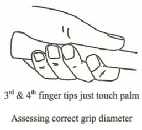
Saddles that are too forward cause increased compression forces at the knee joint, knee flexion and hip extension.
Muscle length becomes less optimal.. Too far back and the hamstring and gluteal muscles are over lengthened and
become less efficient.
The Reach position of the handlebars is affected by a number of factors.
Good positioning is achieved when the pelvis is anteriorally (forward) tilted, a flat back between hips and shoulders,
unlocked elbows with relaxed arms and shoulder (blades) retracted in neutral.
Fine adjustments can be made to take account of the position of feet, cleat position, crank length, type of handlebar
and seat, aerodynamic position and pedaling technique. Always seek professional advice for bike fitting or ask us for advice
A golf club connects the player’s body and the golf ball. The club should be well suited to the player and their swing dynamics.
If the club is not sized or used correctly the player must ‘compensate’ for this and the risk of injury is increased.
This section is under construction. Please return soon
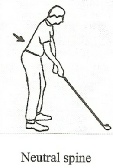
During the golf swing the club will flex and twist thereby changing the position and attitude of the club head at the point of contact.
Lie Angle: At stance the toe of the club head should be slightly raised relative to heel.
With increasing club head speed during the swing the club flexes downwards so that at contact with the ball the sole of the club head should be parallel with the ground.
Contact near the heel of the club head mean the lie angle is too small and causes the club face to become more closed and will generally pull the ball to the left, similar to what occurs with too flat a swing plane or a shaft that is too long.
Contact near the toe of the club head may cause the opposite to occur.
Correct club selection allows the player to perform an effective, efficient and consistent shot.
- Shaft length: Standard club size is based on male (178 cm) and female (163 cm) height and the standard iron shaft length for males is approx 96 cm and a female is 93 cm.
The driver length is 109 cm and 103 cm respectively.
Graphite clubs, being lighter, are usually longer. A longer shaft has more flex and vice versa.
A number of methods are used to determine correct shaft length. ‘Knuckle Height’ is often used to determine the correct shaft length. Standing upright, with the hand by the side (closed fist), measure from the floor to the knuckle of the left middle finger. Retail outlets will have tables so the correct size of club can be selected
- Grip size: A number of methods may be used. When the club is held by the left (top) hand. With the correct grip size the tips of the 3rd and 4th fingers should just touch the thumb side of the palm.
Extra layers of grip tape may be used to increase the grip size.
A grip that is too large is less efficient and effective increasing the risk of tennis/golfers elbow and wrist tendonitis.
Excessively small grip increase joints sprain and can lead to pain and arthritis.
- Set-up stance / Address Posture: This can lead to an effective dynamic swing and ball strike. The knees should be bent 25-30’. The trunk should also be bent forward 25-30’ with the spine aligned straight between the hip and shoulder level. The bottom should feel slightly stuck outwards behind.
- Club Head Speed / Torque: This will affect the flex occurring within the shaft of the club during the golf swing. The faster the head speed the greater the flex.
The amount of torque or twist occurring in the club during the swing will determine the degree to which the club face is open or closed at contact and thus will determine which direction the ball will travel
The main factors to consider are seat height, saddle fore / aft position and arm reach.
The cyclist should be warmed up when setting up the bike.
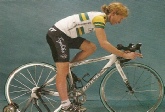
The seat height is correct when the pedal crank is in line with the rear tube of the frame and:-
- The pelvis is level
- The knee is at 250-300 off fully extended and
- The foot is parallel to the floor (neutral at ankle).
- The knee is fully extended at the bottom of the pedal stroke.
This position will be the distance from the top of the saddle to the centre of the bottom bracket along the line of the
back tube of the frame OR is equal to the inside leg seam measure x 0.88
A number of additional factors need to be considered to to fine tune final seat height.
Too high a seat gives less power, stresses the hamstring and calf muscles and excessive hip extension destabilises the pelvis.
Too low a seat increases pressure on the knee cap joint and is less effective for the muscles.
The fore / aft position of the saddle is important for knee loading. The correct position is where the front of the knee is vertically above the centre of the pedal axis.
A number of factors affect the final position including event type, rider size, hip flexibility and bike stability/handling.
Some riders like a slightly forward tilted saddle.

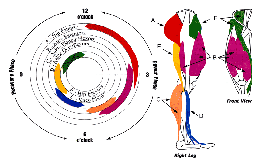


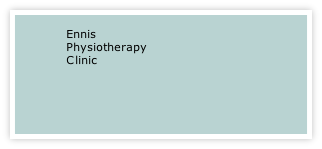




Mon - Fri 9.30am - 8.30pm


3A Barrack Close, Barrack St., Ennis, Co. Clare V95 X437

065 6840757
| Health+Safety Services |
| Sports Clubs+Teams Services |
| Standing Posture |
| Sitting Posture |
| Childhood Posture |
| Using Portable Devices |
| Normal Walking |
| Running |
| Running Drills Videos |
| Muscle Energetics |
| General Fitness |
| Losing Body Weight |
| Gaining Body Weight |
| Weight Loss Programmes |
| Start to Run |
| Start to Swim |
| Start Cycling |
| Start Nordic Waliking |
| Rehab of Tensdons |
| Loading of Tendons |
| Non Specific LBP |
| Posture |
| Intervertebral Disc |
| LBP Treatment |
| Non Specific Neck Pain |
| Neck Care Advice |
| Hamstring Strain |
| Ankle Sprain |
| ACL Injury |
| Joint Replacement |
| Shoulder Dislocation |
| Tennis Elbow |
| Wrist fracture |
| Fractured Knuckle |
| Selecting a Racquet |
| Racquet Grip Size |
| Racuet Sport Injuries |
| Training for Racquet Sports |
| Ski + Board Injuries |
| Injury Videos |
| Injury Prevention |
| Preventing Injury in Musicians |
| Irish Dancing |
| Preventing Dance Injury |